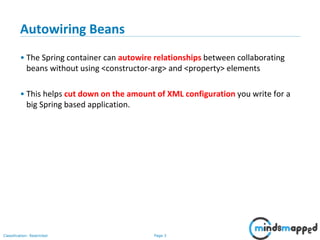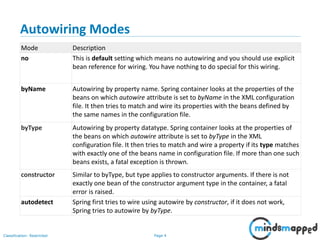Spring - Part 2 - Autowiring, Annotations, Java based Configuration - slides
- 1. Java Spring Training Spring Continued…
- 2. Page 1Classification: Restricted Agenda • Auto-wiring • Annotations based configuration • Java based configuration
- 3. Java & JEE Training Autowiring
- 4. Page 3Classification: Restricted Autowiring Beans • The Spring container can autowire relationships between collaborating beans without using <constructor-arg> and <property> elements • This helps cut down on the amount of XML configuration you write for a big Spring based application.
- 5. Page 4Classification: Restricted Autowiring Modes Mode Description no This is default setting which means no autowiring and you should use explicit bean reference for wiring. You have nothing to do special for this wiring. byName Autowiring by property name. Spring container looks at the properties of the beans on which autowire attribute is set to byName in the XML configuration file. It then tries to match and wire its properties with the beans defined by the same names in the configuration file. byType Autowiring by property datatype. Spring container looks at the properties of the beans on which autowire attribute is set to byType in the XML configuration file. It then tries to match and wire a property if its type matches with exactly one of the beans name in configuration file. If more than one such beans exists, a fatal exception is thrown. constructor Similar to byType, but type applies to constructor arguments. If there is not exactly one bean of the constructor argument type in the container, a fatal error is raised. autodetect Spring first tries to wire using autowire by constructor, if it does not work, Spring tries to autowire by byType.
- 6. Page 5Classification: Restricted Autowiring - byName <!-- Definition for textEditor bean --> <bean id="textEditor" class="demo.TextEditor"> <property name="spellChecker" ref="spellChecker" /> <property name="name" value="Generic Text Editor" /> </bean> <!-- Definition for spellChecker bean --> <bean id="spellChecker" class="demo.SpellChecker"> </bean> <!-- Definition for textEditor bean --> <bean id="textEditor" class="demo.TextEditor" autowire="byName"> <property name="name" value="Generic Text Editor" /> </bean> <!-- Definition for spellChecker bean --> <!– SpellChecker spellchecker = new SpellChecker(); --> <bean id="spellChecker" class="demo.SpellChecker"> </bean> <!-- Definition for spellChecker bean --> <bean id="spellChecker2" class="demo.SpellChecker"> </bean>
- 7. Page 6Classification: Restricted Autowiring - byType <!-- Definition for textEditor bean --> <bean id="textEditor" class="demo.TextEditor"> <property name="spellChecker" ref="spellChecker" /> <property name="name" value="Generic Text Editor" /> </bean> <!-- Definition for spellChecker bean --> <bean id="spellChecker" class="demo.SpellChecker"> </bean> <!-- Definition for textEditor bean --> <bean id="textEditor" class="demo.TextEditor" autowire="byType"> <property name="name" value="Generic Text Editor" /> </bean> <!-- Definition for spellChecker bean --> <bean id="SpellChecker" class="demo.SpellChecker"> </bean> <!-- Definition for spellChecker bean; Only one bean definition allowed.--> <bean id="SpellChecker1" class="demo.SpellChecker"> </bean>
- 8. Page 7Classification: Restricted Autowiring - constructor <!-- Definition for textEditor bean --> <bean id="textEditor" class="demo.TextEditor"> <constructor-arg ref="spellChecker" /> <constructor-arg value="Generic Text Editor"/> </bean> <!-- Definition for spellChecker bean --> <bean id="spellChecker" class="demo.SpellChecker"> </bean> <!-- Definition for textEditor bean --> <bean id="textEditor" class="demo.TextEditor“ autowire="constructor"> <constructor-arg value="Generic Text Editor"/> </bean> <!-- Definition for spellChecker bean --> <bean id="SpellChecker" class="demo.SpellChecker"> </bean>
- 9. Page 8Classification: Restricted Exercise… • Try autodetect mode.
- 10. Java & JEE Training Annotation Based Configuration
- 11. Page 10Classification: Restricted Annotation Based Configuration • Starting Spring 2.5, instead of using XML to describe a bean wiring, you can move the bean configuration into the component class itself by using annotations on the relevant class, method, or field declaration. • Annotation injection is performed before XML injection, thus the latter configuration will override the former for properties wired through both approaches.
- 12. Page 11Classification: Restricted Switching on Annotation based configuration/wiring • Not switched on by default. • Enable it in the configuration xml file. <?xml version="1.0" encoding="UTF-8"?> <beans xmlns="http://www.springframework.org/schema/beans" xmlns:xsi="http://www.w3.org/2001/XMLSchema-instance" xmlns:context="http://www.springframework.org/schema/context" xsi:schemaLocation="http://www.springframework.org/schema/beans http://www.springframework.org/schema/beans/spring-beans.xsd http://www.springframework.org/schema/context http://www.springframework.org/schema/context/spring-context.xsd"> <context:annotation-config/> <!-- bean definitions go here --> </beans>
- 13. Page 12Classification: Restricted Switching on Annotation based configuration/wiring • Once <context:annotation-config/> is configured, you can start annotating your code to indicate that Spring should automatically wire values into properties, methods, and constructors. • Following significant annotations are used: @Required @Autowired @Qualifier
- 14. Page 13Classification: Restricted @Required Annotation • applies to bean property setter methods and it indicates that the affected bean property must be populated in XML configuration file at configuration time • otherwise the container throws a BeanInitializationException exception public class Student { private Integer age; private String name; @Required public void setAge(Integer age) { this.age = age; } public Integer getAge() { return age; } @Required public void setName(String name) { this.name = name; } public String getName() { return name; } }
- 15. Page 14Classification: Restricted @Autowired • provides more fine-grained control over where and how autowiring should be accomplished. • The @Autowired annotation can be used to autowire bean on the setter method just like @Required annotation, constructor, a property or methods with arbitrary names and/or multiple arguments.
- 16. Page 15Classification: Restricted @Autowired on setter methods • Use @Autowired annotation on setter methods to get rid of the <property> element in XML configuration file. • When Spring finds an @Autowired annotation used with setter methods, it tries to perform byType autowiring on the method. //Student.java private Address address; @Autowired public void setAddress( Address address){ this.address = address; } <context:annotation-config/> <!-- Definition for student bean without constructor-arg --> <bean id=“student" class=“demo.Student"> </bean> <!-- Definition for address bean --> <bean id=“address" class=“demo.address"> </bean>
- 17. Page 16Classification: Restricted @Autowired on Constructors • A constructor @Autowired annotation indicates that the constructor should be autowired when creating the bean, even if no <constructor-arg> elements are used while configuring the bean in XML file. private SpellChecker spellChecker; @Autowired public TextEditor(SpellChecker spellChecker){ System.out.println("Inside TextEditor constructor." ); this.spellChecker = spellChecker; } <context:annotation-config/> <!-- Definition for textEditor bean without constructor-arg --> <bean id="textEditor" class="demo.TextEditor"> </bean> <!-- Definition for spellChecker bean --> <bean id="spellChecker" class="demo.SpellChecker"> </bean>
- 18. Page 17Classification: Restricted @Autowired(required=false) • By default, the @Autowired annotation => the dependency is required similar to @Required annotation. • However, you can turn off the default behavior by using (required = false) option with @Autowired. public class Student { private Integer age; private String name; @Autowired(required=false) public void setAge(Integer age) { this.age = age; } public Integer getAge() { return age; } @Autowired public void setName(String name) { this.name = name; } public String getName() { return name; } }
- 19. Page 18Classification: Restricted @Qualifier with @Autowired – remove confusion public class Profile { @Autowired @Qualifier("student1") private Student student; public Profile(){ System.out.println("Inside Profile constructor." ); } …. <context:annotation-config/> <!-- Definition for profile bean --> <bean id="profile" class="demo.Profile"> </bean> <!-- Definition for student1 bean --> <bean id="student1" class="demo.Student"> <property name="name" value="Zara" /> <property name="age" value="11"/> </bean> <!-- Definition for student2 bean --> <bean id="student2" class="demo.Student"> <property name="name" value="Nuha" /> <property name="age" value="2"/> </bean>
- 20. Java & JEE Training Java Based Configuration
- 21. Page 20Classification: Restricted Java based configuration using- @Configuration and @Bean import org.springframework.context.annotation.*; @Configuration public class HelloWorldConfig { @Bean public HelloWorld helloWorld(){ return new HelloWorld(); } } <beans> <bean id="helloWorld" class=“demo.HelloWorld" /> </beans> ApplicationContext ctx = new AnnotationConfigApplicationContext(HelloWorldConfig.class); HelloWorld helloWorld = ctx.getBean(HelloWorld.class);
- 22. Page 21Classification: Restricted Java based configuration… Injecting bean dependency import org.springframework.context.annotation.*; @Configuration public class AppConfig { @Bean public Foo foo() { return new Foo(bar()); } @Bean public Bar bar() { return new Bar(); } } ?? Complete the exercise..
- 23. Page 22Classification: Restricted Java based configuration - @Import @Configuration public class ConfigA { @Bean public A a() { return new A(); } } @Configuration @Import(ConfigA.class) public class ConfigB { @Bean public B a() { return new A(); } } ApplicationContext ctx = new AnnotationConfigApplicationContext(ConfigB.class);
- 24. Page 23Classification: Restricted Specifying Bean Scope @Configuration public class AppConfig { @Bean @Scope("prototype") public Foo foo() { return new Foo(); } }
- 25. Page 24Classification: Restricted Topics to be covered in next session • Spring AOP • What is AOP • AOP Terminologies • AOP Implementations

























